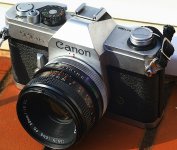- Messages
- 1,449
- Edit My Images
- Yes
This is somewhat of a rant, but i'm interested to see if anyone else is having serious reliability issues with their Canon bodies as of late.
I've been a professional photographer for almost 15 years now, and in the last 3-4 years have had more issues with Canon bodies than I have in the previous decade.
Thoughout my entire early stages of photography, since I was about 18 in the early 2000s, I've used the Canon, Sony and Nikon for years with almost no problems. I put nearly half a million shutter actuations into multiple 5D Mark II and Mark III bodies with zero issues. I used Sony for a few years without so much as a single error message. I'm an event photographer and formally press, so my bodies have always had fairly heavy use.
In recent years i've had constant issues with Canon cameras:
Canon R3
I bought an R3 just over a year ago and it's broken FOUR times. It's had two complete shutter replacements, multiple error messages and has just broken yet again after it's latest shutter replacement in November.
Canon C70
I use this camera regularly, and have had two of them completely break. The first bricked itself 2 weeks after purchase. WEX replaced it with a new one which then failed about 6 months later requiring a complete PCB replacement.
It's not just me that's had issues with this camera, but all of the other freelancers I work with. Between us we've sent back about 10-15 C70s for repair for multiple issues: base plate breaking, lens mount errors, LCD becoming lose and falling off, units completely bricking themselves, dead pixels, autofocus failures and more.
Canon R6
Currently showing an Err 20 error, potentially relating to the shutter. It still works though, the error dispears after it boots. Has done less than half of it's shutter actuation rating, not even 100,000 actuations and the R6 shutter is rated to 300,000 actuations.
I have an R5 that's so far not had any major issues, it's only 7 months old, but does have a super loose hotshoe that i'm concerned will break off, and I know people have had singificant issues with their R5s.
What is going on at Canon. Professional grade bodies like the R3 that cost upwards of £5k should not have this many problems. I could write off a single shutter replacement as getting unlucky, but four camera failures and 2 shutter replacements in under 18 months is a joke.
Anyone else having reliability issues with mirrorless Canon cameras in recent years?
I've been a professional photographer for almost 15 years now, and in the last 3-4 years have had more issues with Canon bodies than I have in the previous decade.
Thoughout my entire early stages of photography, since I was about 18 in the early 2000s, I've used the Canon, Sony and Nikon for years with almost no problems. I put nearly half a million shutter actuations into multiple 5D Mark II and Mark III bodies with zero issues. I used Sony for a few years without so much as a single error message. I'm an event photographer and formally press, so my bodies have always had fairly heavy use.
In recent years i've had constant issues with Canon cameras:
Canon R3
I bought an R3 just over a year ago and it's broken FOUR times. It's had two complete shutter replacements, multiple error messages and has just broken yet again after it's latest shutter replacement in November.
Canon C70
I use this camera regularly, and have had two of them completely break. The first bricked itself 2 weeks after purchase. WEX replaced it with a new one which then failed about 6 months later requiring a complete PCB replacement.
It's not just me that's had issues with this camera, but all of the other freelancers I work with. Between us we've sent back about 10-15 C70s for repair for multiple issues: base plate breaking, lens mount errors, LCD becoming lose and falling off, units completely bricking themselves, dead pixels, autofocus failures and more.
Canon R6
Currently showing an Err 20 error, potentially relating to the shutter. It still works though, the error dispears after it boots. Has done less than half of it's shutter actuation rating, not even 100,000 actuations and the R6 shutter is rated to 300,000 actuations.
I have an R5 that's so far not had any major issues, it's only 7 months old, but does have a super loose hotshoe that i'm concerned will break off, and I know people have had singificant issues with their R5s.
What is going on at Canon. Professional grade bodies like the R3 that cost upwards of £5k should not have this many problems. I could write off a single shutter replacement as getting unlucky, but four camera failures and 2 shutter replacements in under 18 months is a joke.
Anyone else having reliability issues with mirrorless Canon cameras in recent years?
Last edited:



